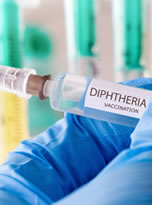Read and report vaccine reactions, harassment and failures.
Diphtheria Disease & Vaccine Information
Diphtheria: The Disease
Diphtheria is a rare toxin-mediated respiratory disease caused by the bacterium Corynebacterium diphtheriae (C. diphtheriae). The production of the toxin only occurs when C. diphtheriae is affected by the specific virus which contains the genetic toxin information. When this happens, the serious disease will occur. There are four different types (biotypes) of C. diphtheriae – belfanti, gravis, intermedius, and mitis. All strains can cause toxin production that can lead to serious disease.
Diphtheria causes a gray-green to black, thick fiber-like covering (pseudomembrane) in the back of the throat and on the tonsils. The pseudomembrane can restrict breathing and swallowing. Learn more about Diphtheria….
Diphtheria: The Vaccine
In the U.S. today, diphtheria vaccine is administered only in a combination shot (DTaP, DT, Tdap, Td) that contains vaccines for tetanus (T), diphtheria (D) and possibly pertussis (whooping cough) (P). It can also be found in combination with vaccines for polio, Haemophilus influenzae B (HIB), and hepatitis B. The U.S. Food and Drug Administration has approved twelve different combination vaccine that include diphtheria toxoid vaccine. There are different rules for use of these vaccines by different age groups.
Not all diphtheria-containing vaccines have been studied in clinical trials to prove the safety and effectiveness of giving the shot simultaneously with other licensed vaccines. Check the product inserts for more information about administering vaccines at the same time with other vaccines. Learn more about Diphtheria Vaccine….
Diphtheria Quick Facts

Diphtheria
- Respiratory diphtheria is a rare bacterial infection with symptoms occurring 2-5 days after exposure. Symptoms include a sore throat, croupy cough, low-grade fever, runny nose, breathing problems, and a fiber-like coating on the tonsils, pharynx, or inside of the nose. Neck swelling (bull neck) is usually present in severe disease. Complications include heart inflammation (myocarditis), neurologic inflammation (neuritis), kidney damage, and airway obstruction. Death occurs in 5-10 percent of respiratory cases.
- Cutaneous diphtheria presents as infected skin lesions that lack a uniform appearance. It is most frequently seen in the tropics or among persons experiencing homelessness. Complications occur less often from this form of diphtheria. Continue reading quick facts....
Diphtheria Vaccine
- There are 12 different diphtheria-containing vaccines licensed for use in the United States, with eight diphtheria combination vaccines available for use in infants and children. These combination vaccines may contain one or more of the following vaccines: pertussis, tetanus, hepatitis B, Hib, and/ or polio. For adults, four diphtheria combination vaccines are available, with two vaccines containing both tetanus and diphtheria toxoids approved for use in adults and children ages seven years and older and two vaccines containing tetanus and diphtheria toxoid and acellular pertussis approved for use in children and adults ages 10 years and older.
- Adverse reactions to combination vaccines containing diphtheria include a temperature of 105F or higher, collapse/shock, persistent crying, convulsions, coma, uncontrolled epilepsy, progressive encephalopathy, and death. Continue reading quick facts....
NVIC encourages you to become fully informed about diphtheria and the diphtheria vaccine by reading all sections in the table of contents, which contain many links and resources such as the manufacturer product information inserts, and to speak with one or more trusted health care professionals before making a vaccination decision for yourself or your child. This information is for educational purposes only and is not intended as medical advice.



